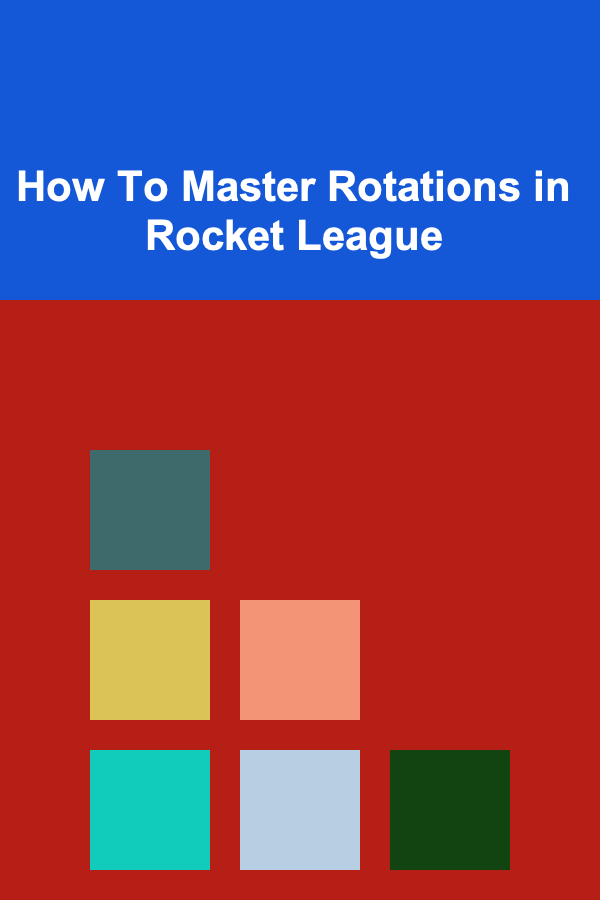
How To Master Rotations in Rocket League
ebook include PDF & Audio bundle (Micro Guide)
$12.99$8.99
Limited Time Offer! Order within the next:

Rocket League is a fast-paced game that blends soccer with rocket-powered cars, creating an exciting and competitive environment. While mechanics like aerial control, dribbling, and shooting often take the spotlight, mastering rotations is just as crucial to success. Understanding rotations will not only elevate your individual gameplay but also enhance your team's overall synergy. In this guide, we will dive deep into how to master rotations in Rocket League, breaking down key concepts, strategies, and tips for effective team play.
What Are Rotations in Rocket League?
In Rocket League, rotations refer to the continuous movement of players across the field in a structured manner to ensure that each player is positioned optimally for both offense and defense. A well-executed rotation ensures that no player is ever out of position, minimizes defensive vulnerabilities, and maximizes offensive pressure.
At its core, rotations involve a cycle where players move between attacking and defensive positions based on the flow of the game. Mastering rotations means understanding when to challenge the ball, when to retreat, and when to position yourself for a future play.
The Basic Rotation Flow
The standard rotation flow in Rocket League typically follows this pattern:
- Player 1 attacks the ball, attempting a shot or pass.
- Player 2 supports by positioning themselves for a follow-up play, either intercepting a rebound or positioning for a pass.
- Player 3 remains in a defensive position, ensuring that any counterattacks are intercepted and that the team doesn't lose possession.
Once the play progresses, the players rotate through these positions. After Player 1 takes the shot or challenges the ball, they rotate to a defensive position while Player 2 moves to the front to take over offensive duties. Meanwhile, Player 3 moves up to fill the gap left by Player 2's previous role. This rotation allows for a continuous cycle of offense and defense, ensuring that players are always positioned for the next play.
Importance of Consistency in Rotations
One of the biggest challenges in Rocket League is maintaining consistent rotations throughout the match. Even when players individually have great mechanics, poor rotations can lead to open gaps in the defense or missed offensive opportunities. By rotating consistently, teams can cover all angles, support each other, and stay in the flow of the game.
Without proper rotation, players might end up out of position, leaving their teammates with no support or creating an opening for the opposing team to exploit. On the other hand, good rotations prevent these issues, maintaining a balanced approach to both offense and defense.
Types of Rotations
While the basic rotation flow follows the general pattern outlined earlier, there are different types of rotations depending on the game situation. These variations allow teams to adapt to different scenarios and playstyles.
1. Offensive Rotation
In an offensive rotation, players focus on maintaining pressure on the opponent's goal while ensuring they stay covered if the ball is cleared. Here's how it typically works:
- Player 1 goes for the ball, either shooting on goal or passing to a teammate.
- Player 2 stays in position to follow up on the ball, either intercepting a rebound or preparing for a pass.
- Player 3 rotates to a defensive position, covering for any counterattacks.
The key to offensive rotations is not overcommitting. Players should be aware of their position on the field, ensuring that they're not all chasing the ball at once. Overcommitting can leave the team vulnerable to counterattacks.
2. Defensive Rotation
Defensive rotations are crucial for preventing goals when the opponent is applying pressure. The main goal is to ensure that the team is always ready to challenge the ball and provide defensive support.
- Player 1 challenges the ball or attempts to clear it.
- Player 2 rotates back to defend the goal, positioning themselves to intercept any passes or shots.
- Player 3 fills in the gap left by Player 2 and prepares for a quick counterattack once the ball is cleared.
Good defensive rotations help teams create a solid wall against offensive pressure while leaving a player ready to launch a counterattack.
3. Shadowing
Shadowing is a more advanced rotation technique where one player stays close to the ball carrier or attacker and applies pressure without committing to an immediate challenge. The shadowing player essentially waits for the opponent to make a move, providing a buffer while ensuring they are ready to intercept or block any shots.
- The shadowing player should stay at a slight angle to the opponent, watching for a moment to capitalize on their mistake.
- Meanwhile, other teammates can move up for an eventual follow-up play.
Shadowing is particularly useful in situations where the ball is in a dangerous area but the attacking player is unsure whether to commit. It buys time for teammates to rotate and fill in.
Key Principles of Effective Rotations
Mastering rotations isn't just about knowing when to move---it's about anticipating where your teammates will be and how the play will evolve. The following key principles will help you improve your rotational play:
1. Always Have One Player Back
One of the simplest yet most important rotational concepts is always having one player ready to defend. This principle ensures that your team will never be caught out of position. Ideally, as one player pushes forward, another should always be in a defensive position to cover for mistakes, rebounds, or clearances. This principle is crucial in 2v2 and 3v3 formats, where the game can change quickly.
2. Don't Overcommit
Overcommitting is a common mistake that happens when multiple players chase the ball at once. This leads to awkward positioning and can leave your team exposed. Instead, focus on working together as a team, where each player rotates in a manner that supports the others while keeping a solid defensive stance. Be patient, and wait for the right opportunity to strike.
3. Be Aware of Boost Management
Boost management plays a significant role in rotations. A player without boost is much less effective at challenging the ball or rotating to another position. Therefore, be mindful of your boost management, and rotate to grab boost pads when needed to ensure you're always in a position to make a play.
4. Communication Is Key
In Rocket League, communication is vital for effective rotations. Whether through voice chat or quick chat commands, communicating your intentions helps teammates anticipate your movements and fill gaps in the rotation. For example, if you're about to challenge the ball, let your teammates know so they can rotate accordingly.
Effective communication also helps coordinate the timing of offensive pushes or defensive clearances. With proper communication, teams can synchronize their rotations and execute precise plays.
5. Adapt to the Opponent's Rotation
Sometimes, the most effective rotations involve countering the opponent's strategies. Observe their movement patterns and adapt your rotation accordingly. If they tend to overcommit, take advantage by waiting for a counterattack. Conversely, if they're particularly strong in defense, adjust by focusing on precise passing plays or creating opportunities for a follow-up shot.
6. Understand Rotation Timing
Timing is crucial in rotations. If a player rotates too early, they may not be in position to support a teammate. On the other hand, rotating too late can result in lost opportunities or missed defensive plays. It's important to find a balance and time your movements according to the situation on the field.
Common Rotational Mistakes to Avoid
While learning how to rotate, many players make certain mistakes that hinder their overall performance. Here are some of the most common errors to avoid:
1. Not Rotating Quickly Enough
If you're too slow to rotate, you may leave your teammates stranded and create gaps in the defense. Always try to predict where you'll be needed next and rotate quickly to fill in the required role.
2. Ignoring Defensive Responsibilities
Some players get so caught up in attacking that they forget to rotate back to defense when needed. Remember, defense should always come first when your team is under pressure. If everyone rushes forward without considering the defense, you're likely to concede a goal.
3. Clumping Together
Clumping together with teammates often happens when everyone chases the ball in a group. This can result in wasted rotations and missed opportunities. Make sure to maintain space on the field, covering both offensive and defensive zones without overlapping your teammates too much.
Conclusion
Mastering rotations in Rocket League is an essential skill that can greatly improve your gameplay and increase your chances of success. Rotations ensure that you and your teammates are always in the right position, whether you're attacking or defending. By understanding the basic principles of rotation, practicing consistently, and avoiding common mistakes, you can elevate your team's coordination and playmaking ability.
Ultimately, rotations are about anticipation, teamwork, and timing. Once you understand how to rotate effectively, you'll notice a significant improvement in your gameplay. Keep practicing, and remember that every rotation is a step towards becoming a better player and contributing more to your team's success.

Advanced Operations Research Techniques for Analysts
Read More
How to Get Your Kids Involved in Gardening and Nature Activities
Read More
How to Manage Your Pet's Anxiety and Stress at Home
Read More
How to Organize Your Kitchen Utensils for Quick Access
Read More
How to Set Up and Maintain an Investment Portfolio
Read More
The Comprehensive Handbook on Health and Safety Policies and Procedures for Health and Safety Officers
Read MoreOther Products

Advanced Operations Research Techniques for Analysts
Read More
How to Get Your Kids Involved in Gardening and Nature Activities
Read More
How to Manage Your Pet's Anxiety and Stress at Home
Read More
How to Organize Your Kitchen Utensils for Quick Access
Read More
How to Set Up and Maintain an Investment Portfolio
Read More